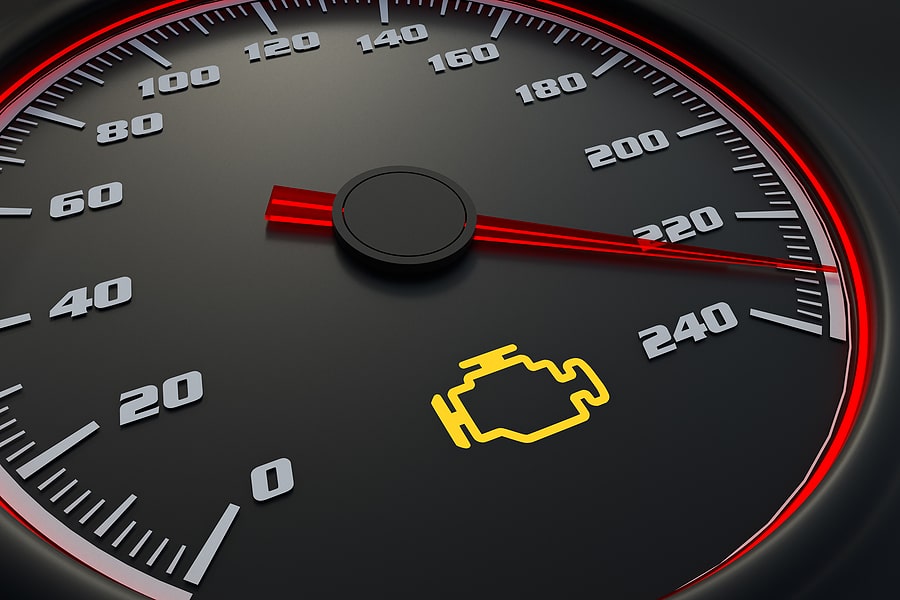As soon as it shows up, it causes a panic in most drivers: the check engine light. Common causes in a Ford include everything from a simple gas cap problem all the way to blown spark plugs, but in all cases, it should not go ignored, especially if it’s flashing. The check engine light in Ford models will appear when something is affecting the engine performance. Ignoring it can lead to lasting damage. Also, many of these issues may lead to a failed emissions test on the Tennessee side of Memphis. If this light is currently glowing or flashing on your dashboard, and you’re living in the Memphis area, schedule an appointment with our service department.

What can cause a check engine light to come on in a Ford?
These are just a few of the issues that might cause an on or blinking check engine light. Ford models share a lot in common with many standard vehicles, but there are a few possible repairs on our list that are unique to this maker.
The 6 Most Common Check Engine Light Causes in Fords
1. A Loose Gas Cap
It’s so simple, and yet it will definitely trip your Ford’s check engine light: a loose or damaged gas cap. Often, this is a result of a missing O-ring; this will need to be replaced. Happily, this is a much simpler repair than some other issues on this list. Note that this may not be applicable to newer Ford models, as they are typically installed with Easy Fuel caps, which eliminates the hassle.
2. O2 Sensor
A high amount of oxygen in your exhaust is a problem leading to a sharp decrease in fuel economy. This code means that fuel will burn too fast and there may be damage to your catalytic converter. This part should be replaced every 50,000 miles and is a relatively cheap repair.
3. Mass Airflow Sensor
Where the O2 sensor measures what’s coming out of your engine, your MAF measures what’s going into it, feeding your engine the right amount of fuel. Left alone, this may cause your engine to stall frequently and cause a host of more serious engine problems.
4. Catalytic Converter
This canister connects to your exhaust system and converts harmful gasses into less harmful emissions. This usually becomes an issue when other issues have been ignored, like the O2 sensor failing.
5. VCTR Solenoid
This problem is common in Ford Fusions; the Variable Camshaft Timing solenoid, which is equipped alongside many four-cylinder engines, can become defective.
6. Ignition Coils and Spark Plugs
This can be a more extreme fix as it features tampering with parts much closer to your engine; however, replacing ignition coils and spark plugs is a fairly normal, routine thing and should be done about every 100,000 miles or so.
Other common issues include a faulty thermostat, a loose vacuum hose and other bad electronic parts.
What is the most common cause of a check engine light for common Ford models?
- Ford Focus Check Engine Light: The on-board computer diagnostic system has hundreds of different codes that can help diagnose the problem. This might be an issue anywhere between a bad spark plug to an O2 sensor. The most common issue in a Focus is either a catalytic converter or a bad battery. A flashing light is indicative of a major issue that needs to be addressed immediately.
- Ford Escape Check Engine Light: Codes from your onboard diagnostic system can help to diagnose the problem. Typical problems include issues with aftermarket parts and a faulty O2 sensor.
- Ford Explorer Check Engine Light: Spark plugs, airflow sensors and your catalytic converter should be checked when you have a check engine light going off – come in immediately if it’s flashing.
- F150 Service Engine Light: Blinking or flashing lights typically indicate a severe issue, and in the F150, that’s usually either an ignition coil failure or a spark plug that’s been ejected from the cylinder head. If it’s not flashing, check your gas cap.
- F250 Check Engine Light: The most common issues for this model are the most common in general: a loose gas cap or a faulty oxygen sensor.
Of course, these issues are the most common, but your car may have a unique or more serious problem, such as a bad fuel injector or other reason for an engine misfire. A local mechanic will be able to use a diagnostic tool and directly find the problem.



